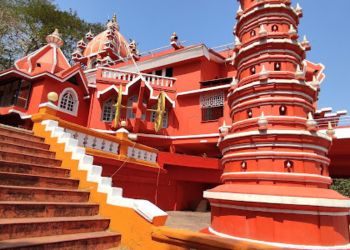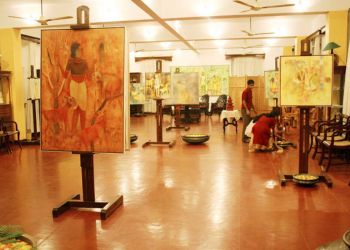Saint Sebastian Chapel in Fontainhas, Goa, is one of the most popular tourist destinations and a pilgrimage site for the Christian followers. This quaint 18th century chapel is dedicated to Saint Sebastian, who treated the one suffering from plagues and other diseases that affected Goa during that period. His selfless service to mankind led to the setting up of this beautiful chapel in Panaji’s Fontainhas.
This whitewashed church has a crucifix, where Christ’s eyes are opened. As per the locals, the crucifix has magical powers to punish the wrongdoers and reward the good ones. Interestingly, the crucifix in the chapel originally stood in the palace of Inquisition in Old Goa in 1560. It was later moved to Adil Shah’s palace or the Old Secretariat. It remained there until the viceroys shifted to a new place at Cabo, from where it was brought to its permanent place at Saint Sebastian Chapel.
History
The 18th century has seen the worst plague outbreak in India and Goa was no exception. Hospitals were packed with sick people and there was no place left to treat them. However, it was when Saint Sebastian came forward to heal those suffering from the disease. People in large numbers started coming to him to seek his aid. His dedication gained immense popularity that the residents decided to build a chapel to honor his service.
The chapel of Saint Sebastian was built in 1818 to honor the saint’s devotion to the people. Since then, it has become a popular tourist hub and pilgrimage site, which is visited by devotees of all faiths.
The Crucifix
The crucifix itself is believed to be over four hundred years old. Legend has it that the crucifix possesses supernatural powers capable of punishing the evil and helping the good. Another interesting fact about the crucifix is that it is the only crucifix with Jesus Christ’s eyes open, which induces fear in the hearts of wrongdoers. It is a testimony of the Inquisition in Goa in 1560, which was an extension of the Portuguese Inquisition in India, that led to the destruction of many temples.
The Chapel
The whitewashed Saint Sebastian church with a crucifix is a sight to behold. It is among the fine examples of Portuguese architecture that is adorning Goa today. It has a small nave with a narrow corridor and the staircase leads to the choir room on the top. The chapel houses a statue of Virgin Mary, three elaborately carved screens, gifted to the chapel by a church in Diu, and two marquetry chests. The chapel also contains an old traditional well attached to it.
It also has a small square, where locals organize the annual Fontainhas festival that is staged in front of the church. This annual street feast is held in mid November to celebrate the Feast of Our Lady of Livrament.
Best Time To Visit
Mid November is considered the best time to visit the chapel, when the neighborhood gears up to celebrate their annual festival. This is also the perfect season to stroll around the city, exploring the various sightseeings.
Nearby Attractions
Maruti Temple
Offer your prayers and seek blessings of Lord Hanuman in Maruti Temple, which is one of the popular religious sites in Fontainhas. The temple, perched atop Altinho Hill, overlooking the Mandovi River, offers some of the most stunning panoramic vistas of the region.

Gitanjali Art Gallery & Panjim Inn
Both these tourist attractions are just a minute away from each other. So, while visiting one, make sure you are visiting the other one later as well. The maroon and white art gallery displays the fantastic artworks done by the local artists and has a huge collection of art and paintings.

Old Portuguese Houses
Take a walk along the old Portuguese houses to soak in the vibrant colors. Learn about the history of the old Latin quarters of Goa. The streets are dotted with several colorful houses. Don’t forget to take a lot of pictures as this is the much-do activity here. The best way to immerse yourself into the alleys of Fontainhas is by staying in one of the heritage inn or hotel here.

Final Thoughts
Saint Sebastian Chapel is one of the city’s old churches, which has a lot of history to share. Although the church was built to honor the selfless service of Saint Sebastian, it is still visited by millions of tourists annually. The best way to appreciate the beauty of the church is to visit it during the annual festival.